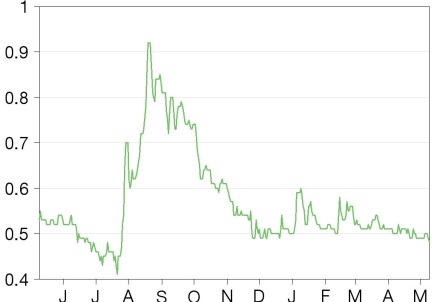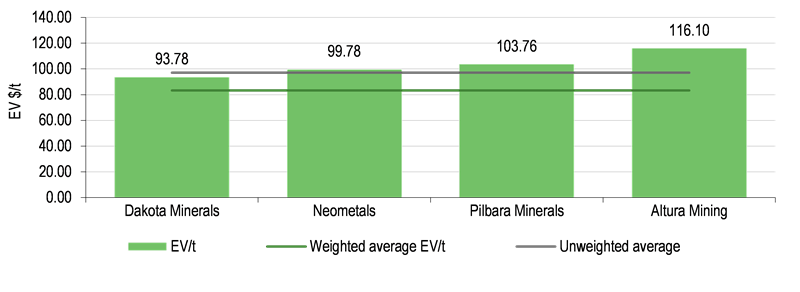The Yangibana rare earth element project
The project is located in north-west Western Australia, approximately 300km east inland from Carnarvon. Cadence has a 30% direct interest (free-carried to BFS) in the Yangibana deposit, which comprises approximately 16% of the Yangibana project, by pit tonnage (see Exhibit 2). Hastings is project manager with a 70% interest. Note that no detail was given in the Hastings Technology Metals’ PFS announcement of 8 April 2016 as to the timing of mining at Yangibana.
In the meantime, however, the project has stated JORC code-compliant resources of 12.4Mt at an average total rare earth oxide (TREO) grade of 1.10%. This is a relatively low grade for a rare earth project. Significantly, however, there has been enrichment of strategically important ‘critical’ rare earth elements, which is the reason that Hastings has targeted production of only the most lucrative rare earth elements as detailed below. Note that the term ‘critical rare earths’ was first coined in a US Department of Energy Critical Materials Strategy study in 2011 and refers to five specific rare earth elements: dysprosium, europium, neodymium, terbium and praseodymium.
The development scope outlined in the 8 April 2016 Yangibana PFS summary details the production of six ‘target’ oxides. These oxides are the precursor feedstock to refined rare earth metal, as well as a host of other alloys. Hastings’ six target rare earth oxides are:
Four of these six target oxides are deemed ‘critical’ by the US Department of Energy, owing to their lack of production outside China and their use in numerous high-tech, military and green-tech applications. Samarium and gadolinium are also important due to their scarce supply outside China.
Exhibit 2: Yangibana REE project open-pit characteristics
|
|
Bald Hill South |
Fraser's |
Yangibana |
Total |
Pit size |
kt |
21,903 |
39,357 |
12,102 |
73,362 |
Strip ratio |
W:O |
6.3 |
10.2 |
20.3 |
9.4 |
Mining inventory |
kt |
2,997 |
3,507 |
569 |
7,074 |
Waste |
kt |
18,906 |
35,849 |
11,533 |
66,289 |
TREO |
% |
0.86 |
1.43 |
0.97 |
1.15 |
Source: Hastings Technology Metals
The Yangibana project PFS details a pre-tax NPV valuation at an 8% discount rate of A$700-750m. We caution that this valuation is based on the projections of REE prices given by Hastings’ consultants in Exhibit 12 and we provide a comparison with REE spot prices and those REE prices used by Alkane Resources to underpin the value of its flagship Dubbo Zirconia Project in NSW, Australia.
Exhibit 3 provides detail on the overall cost of production at the Yangibana REE project. Note that the unit cost values given below relate to the production of concentrate, while the price deck gives values per refined REE metal; as such, these two values should not be compared directly.
Exhibit 3: Yangibana operating cost breakdown
Category |
Total LOM value low-end (US$m) |
Total LOM value upper-end (US$m) |
Unit cost low-end (US$/t) |
Unit cost upper-end (US$/t) |
Contract mining |
340 |
350 |
340 |
350 |
Labour |
175 |
190 |
175 |
190 |
Power/fuel |
65 |
75 |
65 |
75 |
Product transport |
45 |
55 |
45 |
55 |
Toll treatment |
240 |
250 |
240 |
250 |
Reagents |
575 |
600 |
575 |
600 |
Other |
90 |
110 |
90 |
110 |
|
|
|
|
|
Total US$/t of REE oxide concentrate produced |
|
|
1,530 |
1,630 |
Source: Hastings Technology Metals’ Yangibana PFS summary
Subsequent to the publication of its PFS, Hastings announced a major resource upgrade at Yangibana in January 2017 and also, in March, that it had successfully completed continuous beneficiation pilot plant testing. The significance of the latter, in particular, was that it a) successfully validated the Yangibana flotation process, b) confirmed 70% TREO recovery at a final concentrate grade of 23% TREO, c) provided a clear indication of progress from bench scale to commercial production, d) successfully generated bulk samples for downstream engineering equipment design testwork, and e) generated concentrate for subsequent hydrometallurgy pilot plant operation.
Illustrative value for Cadence’s interest in Yangibana
On a 100% basis, the ore tonnages set out in Exhibit 2 for the Yangibana deposit constitute only 16% of the total ore tonnages mined across all three deposits. Cadence’s 30% direct interest in the Yangibana deposit therefore provides Cadence with c 5% of the total tonnages mined across all deposits.
For illustrative purposes, 5% of the entire project’s value based on the outcome of the PFS (we have reconstructed the DCF based on the detail provided in the 8 April 2016 announcement) potentially results in a c A$35m or c £18m valuation, which equates to 0.23p per Cadence share (pre-tax, undiluted and at a 10% discount rate).
Self-evidently, the application of a 5% factor applied to the NPV of a project based on a mine plan back-engineered from the detail provided in a regulatory ASX announcement on the basis of pit tonnages alone is subject to a degree of error and the reason that Edison describes this valuation as ‘illustrative’ only. Our ultimate valuation will depend upon a number of factors including, not least, the scheduling of the Yangibana pit tonnages relative to those of Bald Pit South and Fraser’s. Alternatively, value could be imputed to Yangibana via Hastings market capitalisation. In this case, Hastings market value of A$46.2m for a 70% interest in the Yangibana project implies a A$66m valuation for a 100% interest and a A$19.8m valuation for Cadence’s 30% interest – or 0.15p per Cadence share.















